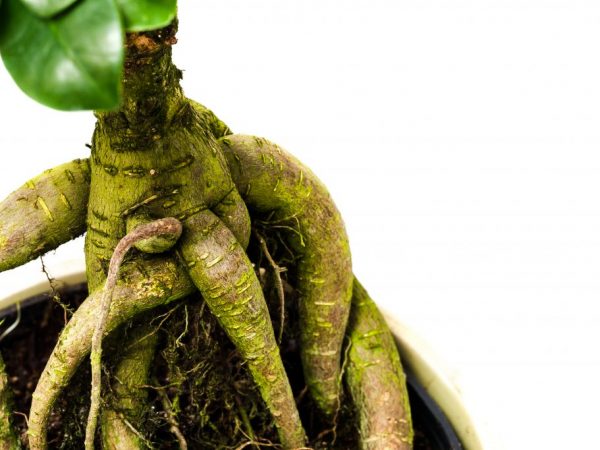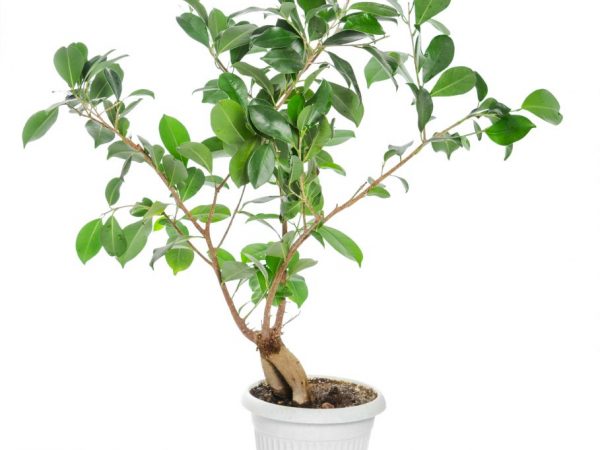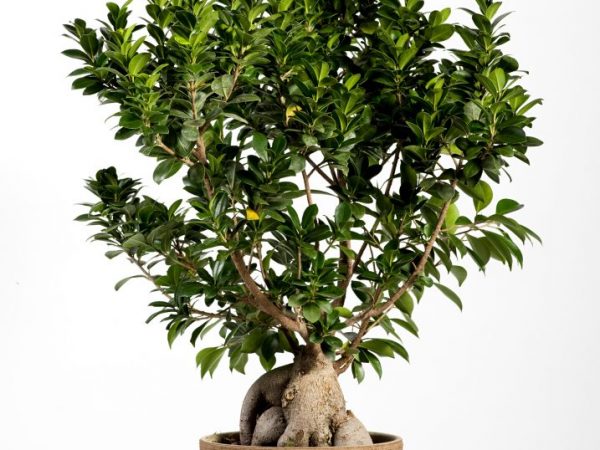Ginseng ficus care
Ficus Ginseng, or ficus Microcarpa Ginseng, is one of the subspecies of ficuses belonging to the mulberry family, which is grown at home. The appearance of this tree is associated with Australia, China, Japan, Malaysia and some other countries of Southeast and East Asia. In the wild, ficus can grow up to 25 m.At home, its maximum height is 1.5 m.

Ginseng ficus care
The Latin name ficus microcarpa ginseng is translated as "ginseng". This evergreen shrub got its name from the similarity of its roots with the root system of the perennial herb ginseng.
General information
There are over 600 species of ficus, most of which are tropical and evergreen. The ficus produces a unique "fruit" that is actually an inverted flower. Ficus Ginseng, or Ficus Microcarpa, is one of the favorites for bonsai creation. It is a great tree for beginner growers as most Ficus species are fast growing, tolerant of different conditions and most types of soil, and do not require special watering methods.
Ginseng Ficus is characterized by its strong roots and stem, on which small, alternating oval dark green leaves grow. They are similar to Benjamin's ficus leaves, but more oval.
Ficus Ginseng has 2 or more heavy, thick, open aerial roots that look more like tree trunks. Ficus Ginseng also has a thick, pot-bellied body that resembles the root of the ginseng plant. The color of the bark can range from gray to reddish. The trunk is dotted with small horizontal spots resembling tiger markings.
Care
Ficus ginseng is one of the best indoor bonsai trees. Home care is straightforward.
Like Benjamin's ficus and albomarginata and other plants in this family, Bonsai ficus does not require much attention. But in order for the tree to grow healthy and lush, you need to follow certain rules for caring for it.
Temperature
Ficus bonsai does not like drafts, so it is important not to place the tree on a windowsill, opposite doors or balconies. It is also important to monitor the temperature regime. The most suitable temperature is between 20 and 23 ° C. In winter, the room where the tree is located should be at least 15 ° C. At a high room temperature or if you keep the plant in the sun, it turns yellow, almost all the leaves fall off, so it is not recommended to place it near a radiator or fireplace.

Protect the plant from drafts
Do not worry if the tree periodically drops several leaves. This is quite normal: this is how the plant gets rid of old unnecessary leaves in order to allow new ones to grow.
Lighting
Ficus trees will grow in low light, but not in bright light. This is the reason why it is necessary to ensure that the green friend does not stand in places of direct sunlight during the summer.Ficus trees do well indoors, but also require going outside in summer. The maximum amount of light will help keep plants healthy and strong.
Growing in dim light will result in poor ficus growth, no flowering, and disease. If the tree is grown indoors, it should be given more window light, which can be increased with artificial lighting for 18 hours a day.
Watering
Ficus should be kept moderately moist. It should be watered well in summer, especially during the hot season, and in winter, reduce irrigation. A moisture tray is a great way to increase moisture. These shallow trays are filled with small stones and have water at the bottom of the tray.
The water should not cover the entire root of the plant to prevent rotting. As the water evaporates, this tray creates the appropriate moisture level that mimics the natural environment of Ficus Bonsai.
Fertilizer
Caring for the Ginseng ficus at home also requires feeding the plant. Bonsai should be fertilized with mineral or organic fertilizers every 2 weeks during the growing season.
In winter, the dose should be reduced. Ficus trees will instantly respond to feeding with beautiful new growth.
Pruning
Leaf pruning can be used to reduce the size of the leaf bed. It is recommended to remove 2-4 leaves after each appearance of 6-10 new leaves. When pruned, the tree will exude a copious amount of quickly drying milky sap.
The formation of the crown of the ficus is necessary in order to give the plant a certain shape and make it more beautiful and lush. The desired shape will be determined by the general view. Sit down with the bonsai tree at eye level and use pruning shears. You can remove any number of leaves. Pruning can be carried out at any time of the year, but in late summer and autumn, after cutting the leaves, scars will not remain.

The crown of the plant needs to be formed
Banyan roots are often grown naturally on the Ginseng ficus. This feature is often demonstrated with the placement of the ficus plant in root air and the stunning root-over-stone style that became popular in the 18th and 19th centuries. The stone chain is designed similar to an open root, but requires a root base to wrap around and under. Rock bonsai in a shallow pot is the perfect yin and yang symbol, depicting the eternal quality of the universe.
Transfer
Ginseng ficus care provides for an annual transplant.
The land in which the tree sprouts must be fruitful and loose. You can transplant the plant into a special purchased soil. Another option is to make your own ficus substrate. This will require sand, leaf or peat soil and wood ash. All these components must be mixed in equal proportions.
Ficus Microcarp is transplanted every year or every two years, but it is necessary to completely change the soil. Often beginners wonder why transplant a plant at all. The fact is that over time, bonsai takes all the nutrients from the ground, and then it cannot grow normally without them.
Breeding
One of the advantages of the Ginseng ficus is its simple cultivation at home. There are several ways to propagate this plant.
Propagation from cuttings
Sequencing:
- from an adult healthy tree, small woody cuttings with several leaves are cut;
- placed in a container with water so that all the milk juice can drain;
- placed in the soil with fertilizers.
Root cuttings

You can propagate a tree with roots
Sequencing:
- a part of the root is cut off from an adult healthy ficus;
- plunges into the soil so that the upper part of the root is above the ground;
- the root is covered with foil and watered every 7 days.
Air layering
Sequencing:
- a part of the bark up to 3 cm wide is cut off from the trunk;
- the trunk without bark is wrapped with a damp cloth and foil;
- when moss appears in this place, it is necessary to maintain its moisture;
- after the appearance of young roots, this part of the trunk is cut off and placed in the ground.
You need to take care of new seedlings in the same way as for an adult plant. It is important not to flood them with water so that the trunk does not rot. If it becomes soft, the young ficus will not take root.
Pests
Bonsai leaves should be kept free of dust and checked regularly for pests or fungi. Taking good care of the Ginseng ficus will go a long way in preventing the appearance of insects and various diseases. Ficus pests are mainly mites and mealy beetles. Yellow, sticky, or colored leaves or cobwebs indicate insect problems.
Most types of insect infestation can be controlled with a harmless solution: 1 tsp. liquid soap in 1 glass of warm water. The plant is sprayed from top to bottom 2-3 times a week. The procedure is repeated as needed.
Growing ficus Ginseng at home will not be difficult. The main thing is proper care, which will help the plant grow big, lush and healthy. This original tree will decorate any interior and will delight the owner every day.


